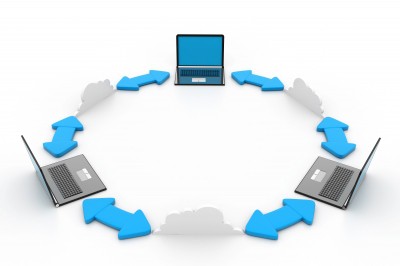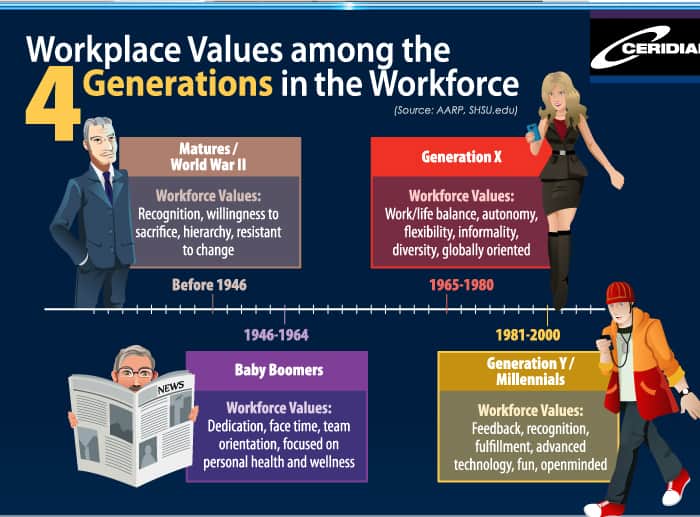
by thepeopleplan | May 25, 2013 | performance
Meet your newest employee pool: Generation Y (or the millennial generation, born 1981-2000). According to the Bureau of Labor Statistics, they are already about 24% of the working population this year.
This month about 1.7 million students will graduate college (most born about 1990). These potential candidates have vastly different impressions of work and reward than their older co-workers (Generation X, Baby Boomers).
According to a study by Sam Houston State University— our youngest team members want “fun, feedback, recognition, open mindedness, and advanced technology” from an employer culture.
Total Rewards expert Towers Watson “2011 Talent Management and Rewards Survey” found that Gen Y-ers looked first for career advancement opportunities, as well as being interested in competitive pay and learning and development (closely related to advancement). These are not a surprising list for anyone beginning their career—they want to learn how to apply the theories learned and develop their knowledge and earning potential.
Unfortunately for you, smaller employer, these are not the rewards that you are known for. Smaller enterprises often pay a bit less than the large companies in their area, lack “formal” career paths, and also tend to be extremely informal about training and development (just in time training might be a flattering description).
The good news is that since this is the worst job market for college graduates in 20 years, you can develop a convincing Employer Brand to position your small firm as a terrific option for this bumper crop of candidates.
Here is a list of questions you can use to differential what you offer, to attract these candidates:
- What is fun about this job? What is challenging about the work?
- How do you describe the People side of your firm—the co-workers, the supervisor, the clients
- What can someone learn in this job? How will this make them more marketable?
- What technology do you have that makes the job easier, cooler, or just less hassles than other similar jobs?
- What autonomy or independence do you give your employees? How about a flexible schedule?
- What does your firm do to help people or do something worthwhile or beneficial to the community?
- Find out what similar employers pay for a similar job, and then offer pay about the same (and communicate why this is competitive)
- Bonus—Gen Y’ers are looking for a position on the web and via social media—what can you do to promote your position and also make it easy for candidates to apply?

Image courtesy of ddpavumba at FreeDigitalPhotos.net

by thepeopleplan | Apr 16, 2013 | culture, job fit, performance
In a study by the Labor Relations Institute of NY, managers selected what they thought employees valued most, and then asked employees what they valued:
Manager /Employee rank- Job Reward
- 1/ 5- Good wages
- 2/ 4- Job security
- 3/ 8- Promotion and growth
- 4/ 9- Good working conditions
- 5/ 6- Interesting work
- 6/ 7- Personal loyalty to workers
- 7/10- Tactful discipline
- 8/ 1- Appreciation for work done
- 9/ 3- Sympathetic help with personal problems
- 10/2- Feeling “in” on things
You can see that the TOP 3 for employees were listed as the BOTTOM 3 in the eyes of managers. Hmm.. I wonder how much time and effort these managers put into these “bottom” rewards if they consider such each a low priority?
As a specialist in compensation, we regularly visit prospective clients who are convinced that their organization needs to pay more to attract, retain and motivate their team members. (And some of them do indeed have issues with pay below the market or internally inequitable.)
However, if your pay is fair for the work you expect and compared to others in your organization, one of the best investments you can make in building a terrific team is with recognition.
Recognition is practically free and creates an immediate impact such as:
- reinforcing company values
- aligning employee efforts to achieve organizational results
- appreciating specific employee efforts (then they continue to do these)
- modeling what ABC- attitudes, behaviors and contributions are valued (others start doing these)
- creating a positive work environment and culture (as more employees demonstrate the desired ABC’s and are recognized for them)
(Manager Survey Source: Foreman Facts, Labor Relations Institute of NY, 2004)
For a Quick recognition template view our 4/23 blog post
Image courtesy of watcharakun at FreeDigitalPhotos.net

by thepeopleplan | Mar 30, 2013 | job fit, performance
The Corporate Executive Board Company (CEB) analyzed performance based on information from more than 20,000 managers and their employees (40 organizations across the globe).
They found 10 competencies differentiated and identified “high performers” able to succeed in our volatile, changing “new work environment.”
These competencies can be categorized into three key areas – adapting to change, working collaboratively, and applying judgment:
Adapt to Change
• Organizational awareness
•Self-awareness
•Proactivity
•Learning agility
Work Collaboratively
•Teamwork
•Influence
•Technical expertise
Apply Judgment
• Prioritization
•Problem solving
•Decision making
According to their research, these competencies are found in about 5% of the working population. They also suggest that “The competencies essential to strong performance in the new work environment are best developed through on-the-job experience with a single company over time.”
What can your small or mid-sized organization due to develop at least part of your staff into high performers by focusing on these skill sets?
Read the full report at:
Identifying and Enabling the New High Performer
Image courtesy of chanpipat at FreeDigitalPhotos.net

by thepeopleplan | Feb 8, 2013 | action plans, job fit
I have the spent the past few weeks having conversations with senior managers in a variety of small and mid-sized organizations, ranging in size from one with 7 employees to one with over 700.
These conversations focus on how we can work together to assist their people to help these organizations achieve 2013 goals, but often the conversation turns to how to develop the staff they have.
These managers like their staff and want to see them grow and contribute more, as well as be more connected to the organization and more fulfilled in their work. They want to retain these team members and to provide meaningful rewards.
Many managers and organizations seem to be challenged by the prospect of how to develop employees, such identifying what skills are needed and how to accomplish this when there is “no time for training.”
A recent book (Help Them Grow or Watch Them Go, Beverly Kaye and Julie Winkle Giulioni) may provide some answers, and challenges some of the myths that prevent smaller employers from focusing development efforts on their team (if they grow they will leave us, the employee is responsible for her own career, it’s about the money, development plans are for the Fortune 500 or just senior managers).
According to Kaye and Giulioni, “Career development is as important as it’s ever been (maybe more). In today’s business environment, talent is the major differentiator. And developing that talent is one of the most significant drivers of employee engagement, which in turn is the key to the business outcomes you seek: revenue, profitability, innovation, productivity, customer loyalty, quality, and cycle time reduction.”
One insight is that employee development can be accomplished with informal, brief, focused “10-minute conversations” that uncover an employee’s aspirations and goals and matches to learning opportunities.
-Diana Southall
Image courtesy of ddpavumba at FreeDigitalPhotos.net

by thepeopleplan | Jan 5, 2013 | coaching, performance
Most small business/ small organization managers interact regularly with their staff members—assigning and coordinating work, answering questions and approving decisions, coaching on skills or techniques, “putting out fires,” and inquiring about progress and status of tasks you assigned.
This is an effective management technique, once dubbed “Management by Wandering Around” by Tom Peters and even given its own acronym MBWA.
The benefits:
Employees appreciate the wandering manager for her accessibility and just in time responses, and managers keep busy and deploy people and resources quickly.
How to improve:
However, MBWA tends to focus a manager’s time and staff’s attention on the daily tasks that consume the day—reacting and getting the job done. This often prevents managers from “getting to my list of projects”—our wish list of projects to improve our operations, customer care, revenue, and costs.
The solution:
In addition to ongoing feedback and coordination, also take time to debrief last year and plan for this one with each employee. Reviewing successes and planning for the coming year involves employees involves employees in creating a challenging and rewarding work plan that will increase their commitment and engagement.
There are several benefits of an annual review meeting with employees:
- Employees expect some type of “formal” review (in a sit down meeting, with written document to review)
- Builds trust and rapport with employees
- Allows employees an outlet to discuss accomplishments and concerns (last year) and job/ career goals (this year)
- Provides opportunity to recognize (and therefore reward with praise) an employee’s accomplishments
- Allows manager to find out what additional responsibilities and work would be challenging and interesting for an employee
- Discuss future department goals and how an employee’s job fits in
- Identify individual action plan items — items from manager’s project list that can be delegated and mutually decide a timeline and plan to accomplish
What should you discuss at this meeting? — here is a short list:
- What are the important achievements of the past year?
- What can be improved in your job to help you be more effective?
- How can I as your supervisor assist you?
- What skills or knowledge do you want to develop in the next year? How can this be accomplished?
So go ahead and schedule a sit down with everyone this month—
it can be lunch in your office, or off site for coffee, or what works with your style.
Your employees will appreciate your time and attention.
As an added benefit- you can delegate some of your “to do’s” to finally get to that wish list this year.
If you finished half your wish list — what could you celebrate at next year’s meeting?
Image courtesy of stockimages at FreeDigitalPhotos.net









